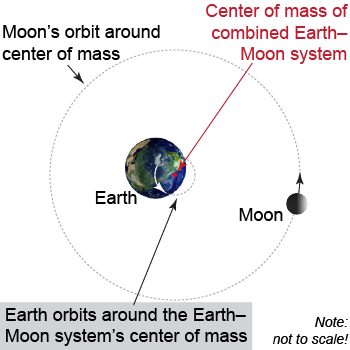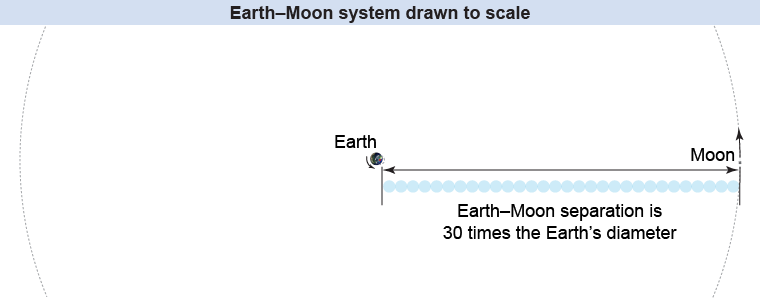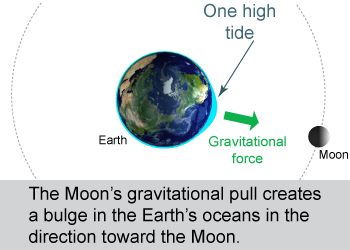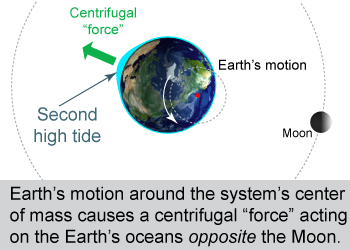|
The tides are a twice daily rise and fall of the ocean level. What causes the tides in the Earth’s oceans? The complete answer requires understanding the center of mass of the Earth–Moon system. 
|
 Even though the Earth is much more massive than the Moon, the Moon does not orbit around the center of the Earth. Instead, the Earth and the Moon both orbit around their combined center of mass. The system’s center of mass is located within the Earth itself, approximately 1,600 km below the surface of the Earth. The Earth travels in a nearly circular orbit around the system’s center of mass, as does the Moon—although the Moon’s orbit is much larger! (Note that the figure is not shown to scale; the Moon is located much further away.)
Even though the Earth is much more massive than the Moon, the Moon does not orbit around the center of the Earth. Instead, the Earth and the Moon both orbit around their combined center of mass. The system’s center of mass is located within the Earth itself, approximately 1,600 km below the surface of the Earth. The Earth travels in a nearly circular orbit around the system’s center of mass, as does the Moon—although the Moon’s orbit is much larger! (Note that the figure is not shown to scale; the Moon is located much further away.) 
 |
 The figure at top (illustrating the center of mass of the Earth-Moon system) is not drawn to scale! The Moon is located much further away than shown in that figure. Most of the Solar System—and the universe as a whole—is empty space!
The figure at top (illustrating the center of mass of the Earth-Moon system) is not drawn to scale! The Moon is located much further away than shown in that figure. Most of the Solar System—and the universe as a whole—is empty space! 
|
 Consider the side of the Earth facing the Moon. The Moon’s gravity exerts an attractive force on the water in the ocean. Unlike solid land, liquid water can flow in response to the Moon’s feeble gravity. As a result, the ocean surface rises a few meters in the “Moonward” direction. This causes one of the high tides on the Earth. But there are two tides per day; the second tide is trickier to explain.
Consider the side of the Earth facing the Moon. The Moon’s gravity exerts an attractive force on the water in the ocean. Unlike solid land, liquid water can flow in response to the Moon’s feeble gravity. As a result, the ocean surface rises a few meters in the “Moonward” direction. This causes one of the high tides on the Earth. But there are two tides per day; the second tide is trickier to explain. 
 |
The Sun exerts a gravitational pull on the Earth, too, so does the Sun create tides? Yes, although they are not as strong as those from the Moon. The reason is that, because the Sun is so far away, it exerts only a small difference in its gravity between the near and far sides of the Earth. So, although the Sun’s gravitational force on the Earth is far stronger than the Moon’s, the Sun only produces tides about half as high as those produced by the Moon. 
|
 The second tide is due mainly to Earth’s 28 day orbit around the Earth–Moon system’s center of mass. This 28 day rotation creates a “centrifugal” effect that tends to move ocean water radially outward and away from the Moon. The effect is similar to what happens if you swing a bucket of water around your head in a circle fast enough that the water stays in the bucket. This centrifugal effect is the cause of the second high tide—the tide that faces away from the Moon.
The second tide is due mainly to Earth’s 28 day orbit around the Earth–Moon system’s center of mass. This 28 day rotation creates a “centrifugal” effect that tends to move ocean water radially outward and away from the Moon. The effect is similar to what happens if you swing a bucket of water around your head in a circle fast enough that the water stays in the bucket. This centrifugal effect is the cause of the second high tide—the tide that faces away from the Moon. 
 |
Some people say that the lunar month—the time it takes the Moon to orbit the Earth—is 27.3 days. Other people say that it is 29.5 days. Who is right? Both are!
It takes 27.3 days for the Moon to make one complete rotation (360°) around the Earth. During that time, however, the Earth has itself moved around the Sun, so it takes an additional two days or so for the Moon to “catch up” to reach the same position relative to the Sun and Earth. The phases of the Moon are a result of the relative positioning of the Earth, Moon, and Sun, so it takes 29.5 days for the Moon to go through a complete cycle of its phases—from one full moon to the next full moon, for example.
The lunar sidereal month is 27.3 days for the Moon to make one complete revolution around the Earth, while the lunar synodic month is 29.5 days for the Moon to go through a complete cycle of its phases. 
|
A more accurate picture is that the ocean surface is distorted into a slightly oval shape while the Earth rotates under the oval’s surface. Both tides lag slightly behind the passing of the Moon overhead due to friction and inertia of huge amounts of water sloshing back and forth between the continents. High tide occurs when a point on Earth’s surface passes through a bulge of the “oval.” Low tide occurs when that point passes in between the two bulges. Tides are highest near the equator and lowest near the poles. 
 |
Because the Sun also contributes to tides on the Earth, there are special times each month when the gravitational forces from both the Sun and the Moon combine to create particularly high and low tides. These spring tides happen when the Moon, Earth, and Sun are all lined up in a nearly straight line, as happens twice every lunar month at the time of the new or full moon. (Note that spring tides occur at any time during the year, not just during spring.) The high tides and low tides that deviate the least from the average ocean level are called neap tides and occur at the first and third quarter moons. 
|
Why is the center of mass of the Earth–Moon system located much closer to the Earth’s center than it is to the Moon’s center?
 |
The Earth is much more massive than the Moon—82 times more massive! As a result, most of the mass of the Earth–Moon system comes from the Earth. The center of mass of the combined system is therefore much closer to the Earth’s center than it is to the Moon’s center. 
|
Does the Moon orbit around the center of the Earth?
 |
No, the Moon orbits around the center of mass of the Earth–Moon system, which is a point located around 4,800 km away from the center of the Earth—although still located within the Earth’s body! 
|

